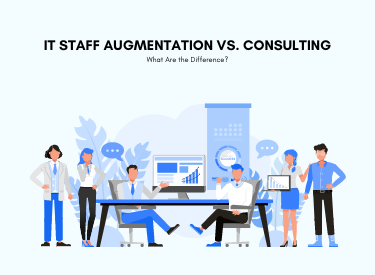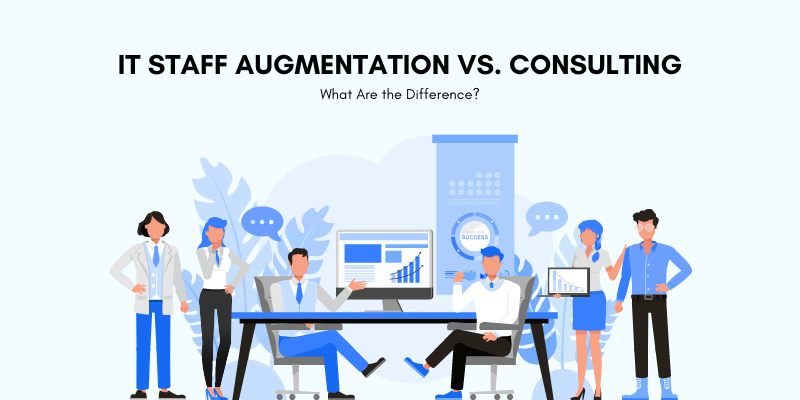IT Staff Augmentation and Consulting: What Are the Difference?

What Is the Difference Between IT Staff Augmentation and Consulting?

You have a lot of options when it comes to finding software development services.
Do you hire new full-time employees to supplement your existing in-house team? Or would hiring a few temporary workers to be faster and less expensive? What if you require a wide range of specialized skills all at once? Is it then preferable to approach a project-based consulting firm?
A variety of factors determines the correct answer. This includes your existing in-house team’s skills and capabilities, any skill shortages you may be experiencing, the unique requirements of your project, your short and long-term goals, the ideal outcomes you hope to achieve, and, most importantly, your budget. These deciding factors significantly impact what the best option for your company is.
Let us assist you in understanding the differences between IT staff augmentation and consulting so that you can make an informed hiring decision. Each hiring method has advantages and disadvantages that should be considered before making a decision. You will find the process more streamlined and the outcome more satisfactory.
What is the difference between IT staff augmentation and consulting?
Staff augmentation is a straightforward concept. It occurs when a business hires one or more third-party specialists to complete a project for them.
These supplemental employees are typically hired temporarily. They are only paid for their work hours and do not receive standard employee benefits such as sick leave or paid holidays. As a result, the hourly rate for staff augmentation is typically higher than if you hire in-house, but you save money by not having to pay for employee benefits.
Staff Augmentation is typically hired for projects with predefined guidelines, parameters, and expectations. They don’t bring anything ‘new’ to the table, at least not in the project scope. The hiring company has handled that.
As a result, the augmented staff is quickly brought on board, briefed on the project scope and expectations, and integrated into the existing in-house team to complete the project.
The two are very different when it comes to staff augmentation vs. consulting. As opposed to staff augmentation, project-based consulting services typically take a more hands-on approach to a project. They are hired to brainstorm, create guidelines, define different workflows and procedures, and then adhere to those parameters to complete the project.
Advantages
- Ideal for businesses that need to quickly expand their in-house team with new or additional skill sets.
- It is less expensive than hiring a project-based consulting firm.
- Hiring new permanent in-house employees requires less commitment and risk.
- There is no need to spend resources or time on staff augmentation training because they already have specialist or generalist skills.
- Augmented employees work in tandem with your existing workflow rather than drastically altering it.
Disadvantages
- It cannot be easy to integrate augmented staff into your existing team.
- Augmented employees may not work in ways that complement your overall vision.
- There is a wide range of cost and skill set differences between staff augmentation, making it difficult to pick the best of the bunch in a crowded market.
- The presence of augmented staff may irritate the in-house team.
Read more: Staff Augmentation vs IT Project Outsourcing: Pros, Cons & Differences
What is project-based consulting vs staff augmentation?
Project-based consulting firms typically offer a wide range of services under one roof, from project conception and planning to staff, project management, and post-launch support.
They are an excellent choice for businesses that require assistance establishing project guidelines, determining the skills and capabilities required, and obtaining the necessary resources to complete the project. As a result, consulting firms play a much larger role in determining a project’s scope and vision than staff augmentation, which typically joins a project after the parameters have already been established.
Furthermore, project-based consulting services offer ongoing supervision, feedback, and a high level of organizational adaptability. This means that consulting firms typically have a specific service method. While there is some leeway, they typically have established service packagers and methods of delivering those services to their clients.
They can also take on multiple clients at once instead of only servicing a few. This may make it more difficult for a hiring company to obtain immediate support and feedback. Before they can get to you, the agency may have to prioritize other clients.
Of course, some agencies may be better equipped to overcome these obstacles, resulting in more consistent customer support.
Advantages
- A broader range of specialist and generalist skills provided by a single, convenient provider
- Capable of assisting with project planning, conceptualization, and execution from start to finish.
- Consulting services relieve the burden on your in-house team, allowing you to focus on what you do best rather than dealing with minor, non-core business duties.
- Consulting services typically employ experienced project managers who ensure your project is delivered smoothly at every stage.
Disadvantages
- Because of their broader range of skills and capabilities, they are typically more expensive than staff augmentation.
- Because consulting services frequently serve multiple clients simultaneously, they may not be as readily available as you would like.
- Most consulting services have a set way of providing their services, so their one-size-fits-all approach may not work for you.
Read more: Dedicated Team vs. Staff Augmentation
What is the difference between staff augmentation and project-based consulting?
Which options are best for you will depend on your specific needs.
IT staff augmentation is ideal for smaller projects that require temporary personnel with specific skills which are readily available. While consulting services are best suited for projects that require a diverse range of specialists and generalists, as well as assistance with planning and project management.
You should also think about what you can afford with your budget. Is the higher hourly rate minus the employee benefits of staffing the most cost-effective option? What would it cost to receive comparable services and outcomes from a project-based consulting firm? Compare the two to determine which option offers the best value for money.
Of course, you should consider the best fit for your company culture. Will your team be open to the addition of augmented staff? If not, what can you do to allay their fears and ensure a smooth collaboration between your in-house and staff augmentation?
Encourage your internal team to express their ideas and opinions. This will assist you in securing augmented staff who meet your specific needs and are likely to get along with your current employees. You have a much better chance of a successful project if you reduce the risk of conflict.
Read more: Managed IT Services vs. IT Staff Augmentation
Summary
Recruiting outsider talent is now easier and more affordable than ever. However, with so many options for hiring new employees, the options can be overwhelming. Hopefully, this article has helped you better understand the various hiring approaches available to you and their distinct advantages and disadvantages.
There is a lot of competition, so do your research and compare your options before making a final decision. This increases your chances of finding the right team for you (at the best price) and receiving a satisfactory result for all parties involved.
